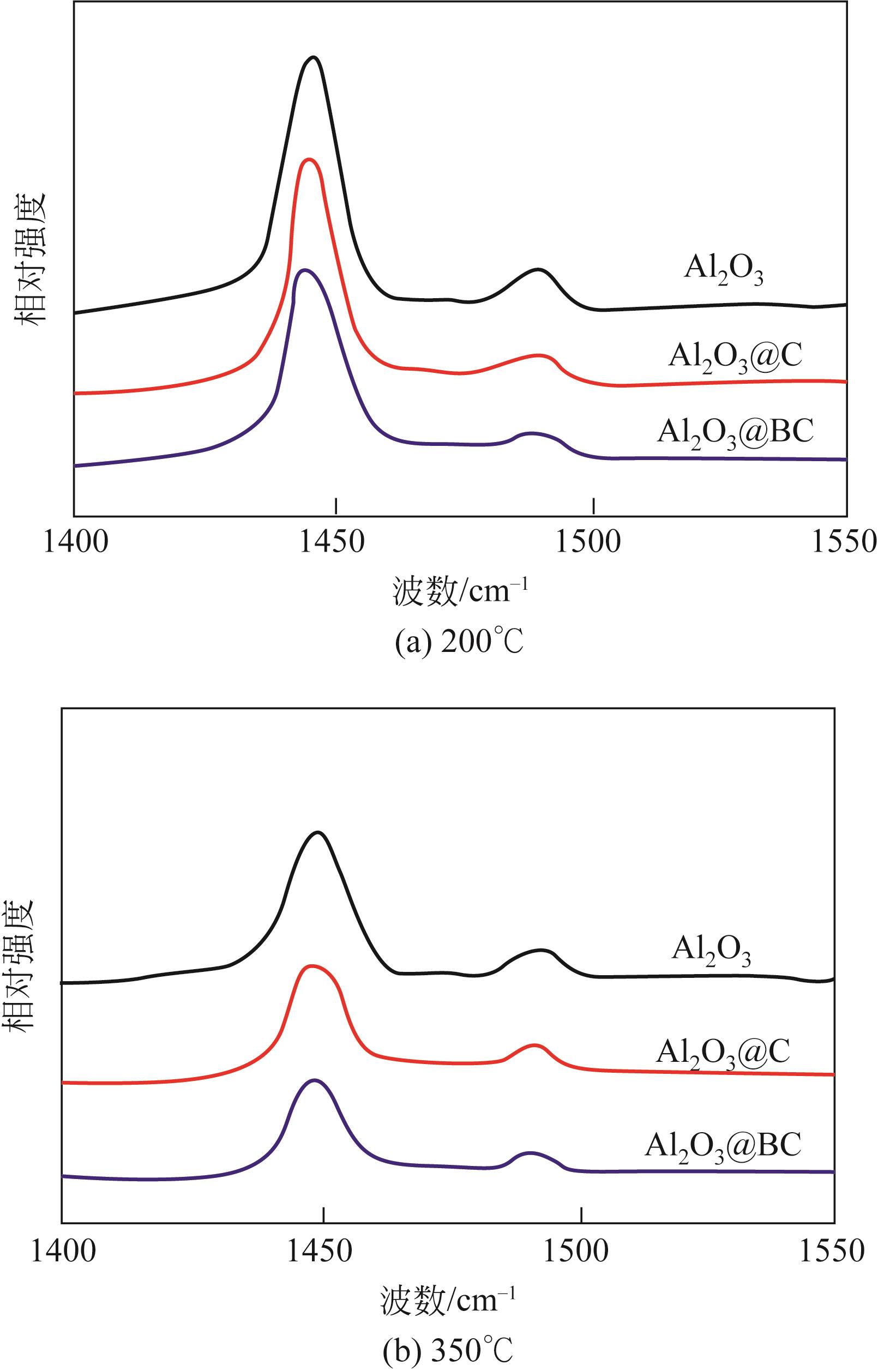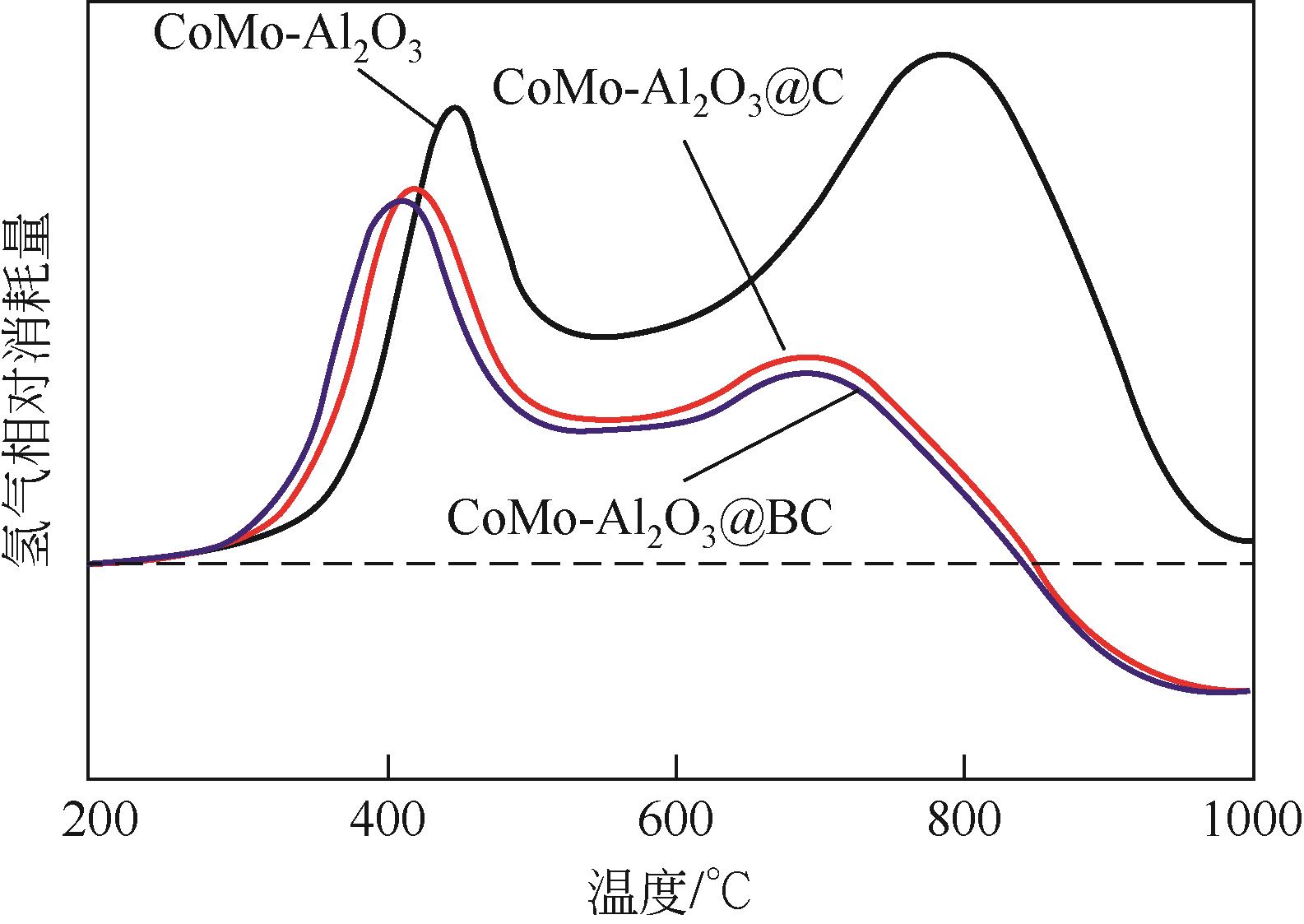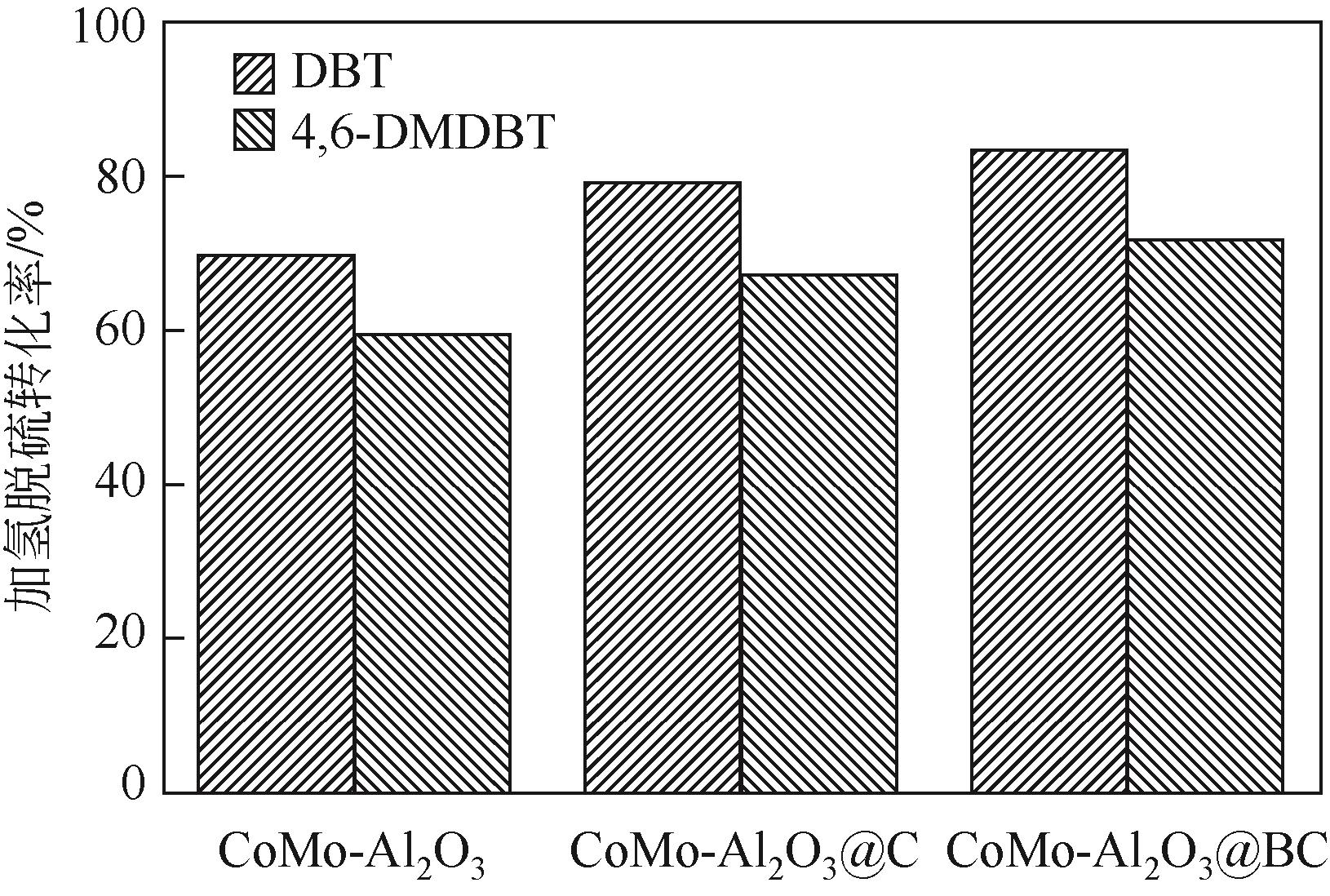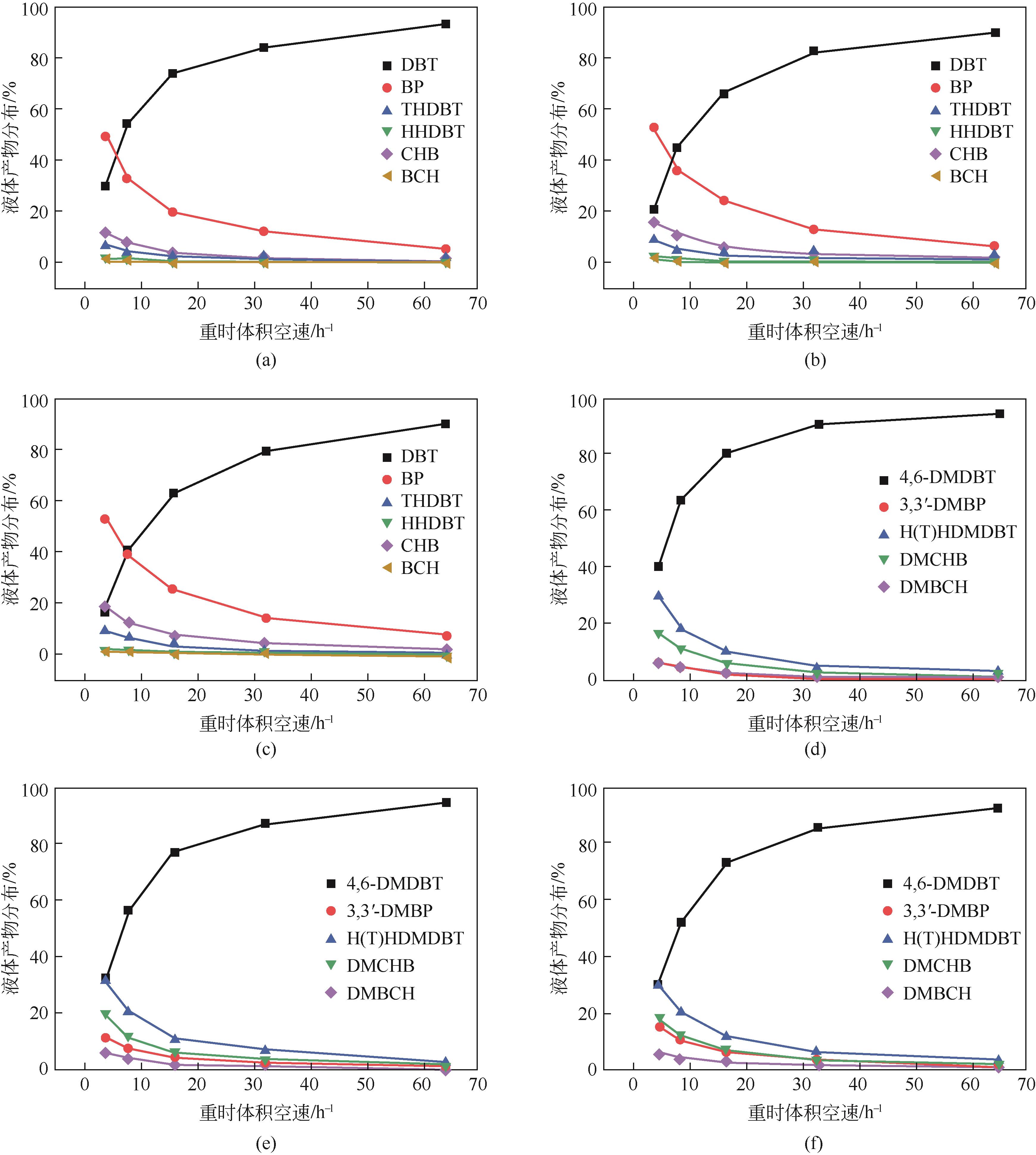化工进展 ›› 2023, Vol. 42 ›› Issue (7): 3550-3560.DOI: 10.16085/j.issn.1000-6613.2022-1575
B掺杂Al2O3@C负载CoMo型加氢脱硫催化剂性能
于志庆1( ), 黄文斌1, 王晓晗1, 邓开鑫1, 魏强1, 周亚松1(
), 黄文斌1, 王晓晗1, 邓开鑫1, 魏强1, 周亚松1( ), 姜鹏2
), 姜鹏2
- 1.中国石油大学(北京)重质油国家重点实验室,北京 102249
2.中国石油集团昆仑资本有限公司,海南 海口 571127
-
收稿日期:2022-08-25修回日期:2022-10-24出版日期:2023-07-15发布日期:2023-08-14 -
通讯作者:周亚松 -
作者简介:于志庆(1992—),男,博士研究生,研究方向为石油和天然气化工。E-mail:yuzqcup@163.com。 -
基金资助:国家自然科学基金(22078360)
B-doped Al2O3@C support for CoMo hydrodesulfurization catalyst and their hydrodesulfurization performance
YU Zhiqing1( ), HUANG Wenbin1, WANG Xiaohan1, DENG Kaixin1, WEI Qiang1, ZHOU Yasong1(
), HUANG Wenbin1, WANG Xiaohan1, DENG Kaixin1, WEI Qiang1, ZHOU Yasong1( ), JIANG Peng2
), JIANG Peng2
- 1.State Key Laboratory of Heavy Oil Processing, China University of Petroleum, Beijing 102249, China
2.CNPC Kunlun Captial Co. , Ltd. , Haikou 571127, Hainan China
-
Received:2022-08-25Revised:2022-10-24Online:2023-07-15Published:2023-08-14 -
Contact:ZHOU Yasong
摘要:
采用碳前体热解预积炭的方法,引入非均相碳层和杂原子硼对氧化铝载体表面性质进行改性掺杂,制备了相应的CoMo负载型加氢脱硫(HDS)催化剂。采用XRD、N2-吸脱附(BET)、Py-FTIR、H2-TPR、HRTEM和XPS等方法对改性氧化铝和CoMo系列负载催化剂进行物理化学性能表征,并对模型化合物DBT和4,6-DMDBT的HDS催化性能进行评价。分析结果表明:碳层的引入可以有效减少氧化铝载体表面的—OH官能团,进而调节氧化铝的酸性和调控活性金属与载体之间的相互作用,避免了CoAl2O4尖晶石的生成。杂原子B的掺杂可使得载体表面产生更多的缺陷位点,增强Mo物种的硫化程度和分散程度,活性金属在载体表面形成更多的“Type Ⅱ”型CoMoS活性相,这有利于复杂含硫化合物的加氢脱除。实验结果显示:270℃下DBT和290℃下4,6-DMDBT在CoMo-Al2O3@BC的催化剂上,重时体积空速为4h-1条件下,HDS转化率最高,分别可达83.42%和69.98%,较CoMo-Al2O3催化剂分提升13.67%和10.40%。
中图分类号:
引用本文
于志庆, 黄文斌, 王晓晗, 邓开鑫, 魏强, 周亚松, 姜鹏. B掺杂Al2O3@C负载CoMo型加氢脱硫催化剂性能[J]. 化工进展, 2023, 42(7): 3550-3560.
YU Zhiqing, HUANG Wenbin, WANG Xiaohan, DENG Kaixin, WEI Qiang, ZHOU Yasong, JIANG Peng. B-doped Al2O3@C support for CoMo hydrodesulfurization catalyst and their hydrodesulfurization performance[J]. Chemical Industry and Engineering Progress, 2023, 42(7): 3550-3560.
| 沥青粉组成质量分数/% | 软化点 /℃ | 堆积密度 /g·cm-3 | |||
|---|---|---|---|---|---|
| 饱和分 | 胶质 | 芳香分 | 沥青质 | ||
| 1.87 | 9.10 | 33.74 | 55.29 | 178.74 | 0.10 |
表1 沥青粉的性质分析
| 沥青粉组成质量分数/% | 软化点 /℃ | 堆积密度 /g·cm-3 | |||
|---|---|---|---|---|---|
| 饱和分 | 胶质 | 芳香分 | 沥青质 | ||
| 1.87 | 9.10 | 33.74 | 55.29 | 178.74 | 0.10 |
| 名称 | SBET/m2·g-1 | V/cm3·g-1 | D/nm |
|---|---|---|---|
| Al2O3 | 258.51 | 0.73 | 9.99 |
| Al2O3@C | 234.82 | 0.68 | 9.12 |
| Al2O3@BC | 231.39 | 0.68 | 8.93 |
| CoMo-Al2O3 | 236.33 | 0.64 | 9.38 |
| CoMo-Al2O3@C | 217.74 | 0.62 | 8.46 |
| CoMo-Al2O3@BC | 215.66 | 0.62 | 8.27 |
表2 不同载体的比表面积和孔结构、孔容
| 名称 | SBET/m2·g-1 | V/cm3·g-1 | D/nm |
|---|---|---|---|
| Al2O3 | 258.51 | 0.73 | 9.99 |
| Al2O3@C | 234.82 | 0.68 | 9.12 |
| Al2O3@BC | 231.39 | 0.68 | 8.93 |
| CoMo-Al2O3 | 236.33 | 0.64 | 9.38 |
| CoMo-Al2O3@C | 217.74 | 0.62 | 8.46 |
| CoMo-Al2O3@BC | 215.66 | 0.62 | 8.27 |
| 名称 | L/nm | N |
|---|---|---|
| CoMo-Al2O3 | 5.1 | 2.8 |
| CoMo-Al2O3@C | 4.8 | 3.8 |
| CoMo-Al2O3@BC | 3.8 | 3.9 |
表3 硫化催化剂二硫化钼板平均长度、层数统计结果
| 名称 | L/nm | N |
|---|---|---|
| CoMo-Al2O3 | 5.1 | 2.8 |
| CoMo-Al2O3@C | 4.8 | 3.8 |
| CoMo-Al2O3@BC | 3.8 | 3.9 |
| 名称 | CoMo-Al2O3 | CoMo-Al2O3@C | CoMo-Al2O3@BC |
|---|---|---|---|
| Mo4+/% | 61 | 73 | 79 |
| Mo5+/% | 16 | 10 | 7 |
| Mo6+/% | 23 | 17 | 14 |
| CoO | 34 | 30 | 24 |
| CoMoS | 54 | 61 | 69 |
| Co9S8 | 10 | 9 | 7 |
表4 硫化态催化剂上Mo 3d及Co 2p电子的XPS表征结果
| 名称 | CoMo-Al2O3 | CoMo-Al2O3@C | CoMo-Al2O3@BC |
|---|---|---|---|
| Mo4+/% | 61 | 73 | 79 |
| Mo5+/% | 16 | 10 | 7 |
| Mo6+/% | 23 | 17 | 14 |
| CoO | 34 | 30 | 24 |
| CoMoS | 54 | 61 | 69 |
| Co9S8 | 10 | 9 | 7 |
| 反应物 | 催化剂 | kHDS/10-4mol·h-1·g-1 | kDDS/10-4mol·h-1·g-1 | kHYD/10-4mol·h-1·g-1 |
|---|---|---|---|---|
| DBT | CoMo-Al2O3 | 2.66 | 1.95 | 0.71 |
| CoMo-Al2O3@C | 3.54 | 2.39 | 1.15 | |
| CoMo-Al2O3@BC | 4.01 | 2.62 | 1.39 | |
| 4,6-DMDBT | CoMo-Al2O3 | 0.86 | 0.10 | 0.76 |
| CoMo-Al2O3@C | 1.05 | 0.11 | 0.94 | |
| CoMo-Al2O3@BC | 1.17 | 0.11 | 1.05 |
表5 DBT和4,6-DMDBT在不同催化剂上的加氢脱硫动力学参数
| 反应物 | 催化剂 | kHDS/10-4mol·h-1·g-1 | kDDS/10-4mol·h-1·g-1 | kHYD/10-4mol·h-1·g-1 |
|---|---|---|---|---|
| DBT | CoMo-Al2O3 | 2.66 | 1.95 | 0.71 |
| CoMo-Al2O3@C | 3.54 | 2.39 | 1.15 | |
| CoMo-Al2O3@BC | 4.01 | 2.62 | 1.39 | |
| 4,6-DMDBT | CoMo-Al2O3 | 0.86 | 0.10 | 0.76 |
| CoMo-Al2O3@C | 1.05 | 0.11 | 0.94 | |
| CoMo-Al2O3@BC | 1.17 | 0.11 | 1.05 |
| 1 | ZHOU Wenwu, ZHANG Yanan, TAO Xiujuan, et al. Effects of gallium addition to mesoporous alumina by impregnation on dibenzothiophene hydrodesulfurization performances of the corresponding NiMo supported catalysts[J]. Fuel, 2018, 228: 152-163. |
| 2 | FU Wenqian, ZHANG Lei, TANG Tiandi, et al. Extraordinarily high activity in the hydrodesulfurization of 4,6-dimethyldibenzothiophene over Pd supported on mesoporous zeolite Y[J]. Journal of the American Chemical Society, 2011, 133(39): 15346-15349. |
| 3 | LAI Weikun, CHEN Zhou, ZHU Jianping, et al. A NiMoS flower-like structure with self-assembled nanosheets as high-performance hydrodesulfurization catalysts[J]. Nanoscale, 2016, 8(6): 3823-3833. |
| 4 | PENG Chong, HUANG Xinlu, DUAN Xuezhi, et al. Direct production of high octane gasoline and ULSD blend stocks by LCO hydrocracking[J]. Catalysis Today, 2016, 271: 149-153. |
| 5 | PENA L, VALENCIA D, KLIMOVA T. CoMo/SBA-15 catalysts prepared with EDTA and citric acid and their performance in hydrodesulfurization of dibenzothiophene[J]. Applied Catalysis B: Environmental, 2014, 147: 879-887. |
| 6 | HAN Wei, NIE Hong, LONG Xiangyun, et al. Preparation of F-doped MoS2/Al2O3 catalysts as a way to understand the electronic effects of the support Brønsted acidity on HDN activity[J]. Journal of Catalysis, 2016, 339: 135-142. |
| 7 | VLASOVA E N, DELIY I V, NUZHDIN A L, et al. Catalytic properties of CoMo/Al2O3 sulfide catalysts in the hydrorefining of straight-run diesel fraction mixed with rapeseed oil[J]. Kinetics and Catalysis, 2014, 55(4): 481-491. |
| 8 | HAN Wei, NIE Hong, LONG Xiangyun, et al. Effects of the support Brønsted acidity on the hydrodesulfurization and hydrodenitrogention activity of sulfided NiMo/Al2O3 catalysts[J]. Catalysis Today, 2017, 292: 58-66. |
| 9 | BALLINGER T H, YATES J T. IR spectroscopic detection of Lewis acid sites on alumina using adsorbed carbon monoxide. Correlation with aluminum-hydroxyl group removal[J]. Langmuir, 1991, 7(12): 3041-3045. |
| 10 | LI Yanpeng, LIU Dapeng, LIU Chenguang. Hydrodesulfurization (HDS) and hydrodenitrogenation (HDN) performance of an ex situ presulfided MoNiP/Al2O3 catalyst: Model compounds study and pilot test for fluidized catalytic cracking (FCC) diesel oil[J]. Energy & Fuels, 2010, 24(2): 789-795. |
| 11 | MILOV M A, RUZANKIN S F, ZHIDOMIROV G M. On the molecular models of lewis acid sites on the surface of γ-Al2O3 and in zeolites: A density functional study of CO adsorption[J]. Journal of Structural Chemistry, 1997, 38(5): 698-702. |
| 12 | KLIMOVA T E, VALENCIA D, MENDOZA-NIETO J A, et al. Behavior of NiMo/SBA-15 catalysts prepared with citric acid in simultaneous hydrodesulfurization of dibenzothiophene and 4,6-dimethyldibenzothiophene[J]. Journal of Catalysis, 2013, 304: 29-46. |
| 13 | NUZHDIN A L, BUKHTIYAROVA G A, PORSIN A A, et al. Effect of mono-, di-, and triethylene glycol on the activity of phosphate-doped NiMo/Al2O3 hydrotreating catalysts[J]. Catalysts, 2019, 9(1): 96. |
| 14 | PAPADOPOULOU C, VAKROS J, MATRALIS H K, et al. Preparation, characterization, and catalytic activity of CoMo/γ-Al2O3 catalysts prepared by equilibrium deposition filtration and conventional impregnation techniques[J]. Journal of Colloid and Interface Science, 2004, 274(1): 159-166. |
| 15 | SUN Mingyong, NICOSIA D, PRINS R. The effects of fluorine, phosphate and chelating agents on hydrotreating catalysts and catalysis[J]. Catalysis Today, 2003, 86(1/2/3/4): 173-189. |
| 16 | RAMIREZ J, MACISA G, CEDENO L, et al. The role of titania in supported Mo, CoMo, NiMo, and NiW hydrodesulfurization catalysts: analysis of past and new evidences[J]. Catalysis Today, 2004, 98(1/2): 19-30. |
| 17 | HARLE V, VRINAT M, SCHARFF J P, et al. Catalysis assisted characterizations of nanosized TiO2-Al2O3 mixtures obtained in molten alkali metal nitrates[J]. Applied Catalysis A-General, 2000, 196(2): 261-269. |
| 18 | ZHANG Pengfei, MU Fujun, ZHOU Yasong, et al. Synthesis of highly ordered TiO2-Al2O3 and catalytic performance of its supported NiMo for HDS of 4,6-dimethyldibenzothiophene[J/OL]. Catalysis Today. . |
| 19 | RAMIREZ J, FUENTES S, DIAZ G, et al. Hydrodesulphurization activity and characterization of sulphided molybdenum and cobalt—molybdenum catalysts : Comparison of alumina-, silica-alumina- and titania-supported catalysts[J]. Applied Catalysis A-General, 1989, 52(1): 211-224. |
| 20 |
MURALIDHAR G, MASSOTH F E, SHABTAI J. Catalytic functionalities of supported sulfides ( ): Effect of support and additives on the CoMo catalyst[J]. Journal of Catalysis, 1984, 85(1): 44-52. ): Effect of support and additives on the CoMo catalyst[J]. Journal of Catalysis, 1984, 85(1): 44-52.
|
| 21 | ZHOU Wenwu, LIU Meifang, ZHOU Yasong, et al. 4,6-Dimethyldibenzothiophene hydrodesulfurization on nickel-modified USY-supported NiMoS catalysts: Effects of modification method[J]. Energy & Fuels, 2017, 31(7): 7445-7455. |
| 22 | LI Lei, WANG Minjian, HUANG Lingxiang, et al. Electron-donating-accepting behavior between nitrogen-doped carbon materials and Fe species and its promotion for DBT hydrodesulfurization[J]. Applied Catalysis B-Environmental, 2019, 254: 360-370. |
| 23 | XU Leilei, SONG Huanling, CHOU Lingjun. One-pot synthesis of ordered mesoporous NiO-CaO-Al2O3 composite oxides for catalyzing CO2 reforming of CH4 [J]. ACS Catalysis, 2012, 2(7): 1331-1342. |
| 24 | ZHAO Ruiyu, ZENG Lingyou, LING Juan, et al. Interaction between Ni promoter and Al2O3 support and its effect on the performance of NiMo/γ-Al2O3 catalyst in hydrodesulphurization[J]. Journal of Fuel Chemistry and Technology, 2016, 44(5): 564-569. |
| 25 | GAO Daowei, DUAN Aijun, ZHANG Xin, et al. Synthesis of NiMo catalysts supported on mesoporous Al-SBA-15 with different morphologies and their catalytic performance of DBT HDS[J]. Applied Catalysis B: Environmental, 2015, 165: 269-284. |
| 26 | LI Lida, XU Chengzhi, ZHENG Meiqin, et al. Effect of B2O3 modified Ag/TiO2-Al2O3 adsorbents on the adsorption desulfurization of diesel[J]. Journal of Fuel Chemistry and Technology, 2015, 43(8): 990-997. |
| 27 | NING Guoqing, HUANG Xiaoqiao, LI Jianwei, et al. Catalytic ability of MgO to break C—H bonds during slurry oil carbon deposition[J]. Particuology, 2018, 38: 222-227. |
| 28 | LIU Qing, GAO Jiajian, GU Fangna, et al. One-pot synthesis of ordered mesoporous Ni-V-Al catalysts for CO methanation[J]. Journal of Catalysis, 2015, 326: 127-138. |
| 29 | PEREZ-RAMIREZ J, VERBOEKEND D, BONILLA A, et al. Zeolite catalysts with tunable hierarchy factor by pore-growth moderators[J]. Advanced Functional Materials, 2009, 19(24): 3972-3979. |
| 30 | YU Quanyong, ZHANG Lei, GUO Rong, et al. Catalytic performance of CoMo catalysts supported on mesoporous ZSM-5 zeolite-alumina composites in the hydrodesulfurization of 4,6-dimethyldibenzothiophene[J]. Fuel Processing Technology, 2017, 159: 76-87. |
| 31 | JOFFRE J, LERBER D A, GEBESTE P. Quantum chemical studies of the adsorption of thiophene on MoS2 hydroprocessing sites[J]. Bulletin des Societes Chimiques Belges, 2010, 93(8/9): 831-838. |
| 32 | WANG Lu, ZHANG Yongna, ZHANG Yuliang, et al. Hydrodesulfurization of 4,6-DMDBT on a multi-metallic sulfide catalyst with layered structure[J]. Applied Catalysis A-General, 2011, 394(1/2): 18-24. |
| 33 | CRISTOL S, J-F PAUL, PAYEN E, et al. DBT derivatives adsorption over molybdenum sulfide catalysts: A theoretical study[J]. Journal of Catalysis, 2004, 224(1): 138-147. |
| 34 | FARAG H. Hydrodesulfurization of dibenzothiophene and 4,6-dimethyldibenzothiophene over NiMo and CoMo sulfide catalysts: Kinetic modeling approach for estimating selectivity[J]. Journal of Colloid and Interface Science, 2010, 348(1): 219-226. |
| 35 | CHANG Jie, WANG Anjie, LIU Jing, et al. Oxidation of dibenzothiophene with cumene hydroperoxide on MoO3/SiO2 modified with alkaline earth metals[J]. Catalysis Today, 2010, 149(1/2): 122-126. |
| 36 | HUANG Weiqiang, DUAN Aijun, ZHAO Zhen, et al. Ti-modified alumina supports prepared by sol-gel method used for deep HDS catalysts[J]. Catalysis Today, 2008, 131(1/2/3/4): 314-321. |
| 37 | LI Mingfeng, LI Huifeng, JIANG Feng, et al. The relation between morphology of (Co)MoS2 phases and selective hydrodesulfurization for CoMo catalysts[J]. Catalysis Today, 2010, 149(1/2): 35-39. |
| [1] | 张明焱, 刘燕, 张雪婷, 刘亚科, 李从举, 张秀玲. 非贵金属双功能催化剂在锌空气电池研究进展[J]. 化工进展, 2023, 42(S1): 276-286. |
| [2] | 胡喜, 王明珊, 李恩智, 黄思鸣, 陈俊臣, 郭秉淑, 于博, 马志远, 李星. 二硫化钨复合材料制备与储钠性能研究进展[J]. 化工进展, 2023, 42(S1): 344-355. |
| [3] | 林晓鹏, 肖友华, 管奕琛, 鲁晓东, 宗文杰, 傅深渊. 离子聚合物-金属复合材料(IPMC)柔性电极的研究进展[J]. 化工进展, 2023, 42(9): 4770-4782. |
| [4] | 单雪影, 张濛, 张家傅, 李玲玉, 宋艳, 李锦春. 阻燃型环氧树脂的燃烧数值模拟[J]. 化工进展, 2023, 42(7): 3413-3419. |
| [5] | 龚鹏程, 严群, 陈锦富, 温俊宇, 苏晓洁. 铁酸钴复合碳纳米管活化过硫酸盐降解铬黑T的性能及机理[J]. 化工进展, 2023, 42(7): 3572-3581. |
| [6] | 杨竞莹, 施万胜, 黄振兴, 谢利娟, 赵明星, 阮文权. 改性纳米零价铁材料制备的研究进展[J]. 化工进展, 2023, 42(6): 2975-2986. |
| [7] | 许春树, 姚庆达, 梁永贤, 周华龙. 氧化石墨烯/碳纳米管对几种典型高分子材料的性能影响[J]. 化工进展, 2023, 42(6): 3012-3028. |
| [8] | 朱雅静, 徐岩, 简美鹏, 李海燕, 王崇臣. 金属有机框架材料用于海水提铀的研究进展[J]. 化工进展, 2023, 42(6): 3029-3048. |
| [9] | 张巍, 秦川, 谢康, 周运河, 董梦瑶, 李婕, 汤云灏, 马英, 宋健. H2-SCR改性铂系催化剂低温脱硝的应用及性能强化挑战[J]. 化工进展, 2023, 42(6): 2954-2962. |
| [10] | 马源, 肖晴月, 岳君容, 崔彦斌, 刘姣, 许光文. CeO2-Al2O3复合载体负载Ni基催化剂催化CO x 共甲烷化性能[J]. 化工进展, 2023, 42(5): 2421-2428. |
| [11] | 张宁, 吴海滨, 李钰, 李剑锋, 程芳琴. 漂浮型光催化材料的制备及其在水处理领域的应用研究进展[J]. 化工进展, 2023, 42(5): 2475-2485. |
| [12] | 陈飞, 刘成宝, 陈丰, 钱君超, 邱永斌, 孟宪荣, 陈志刚. g-C3N4基超级电容器用电极材料的研究进展[J]. 化工进展, 2023, 42(5): 2566-2576. |
| [13] | 刘念, 陈葵, 武斌, 纪利俊, 吴艳阳, 韩金玲. 蛋黄-壳介孔磁性炭微球的制备及其对红霉素的高效吸附[J]. 化工进展, 2023, 42(5): 2724-2732. |
| [14] | 王嘉, 彭冲, 唐磊, 陆安慧. 渣油加氢催化剂活性相结构调控及对反应性能影响[J]. 化工进展, 2023, 42(4): 1811-1821. |
| [15] | 陈仪, 郭耀励, 叶海星, 李宇璇, 牛青山. 二维纳米材料在渗透汽化脱盐膜中的应用[J]. 化工进展, 2023, 42(3): 1437-1447. |
| 阅读次数 | ||||||
|
全文 |
|
|||||
|
摘要 |
|
|||||








